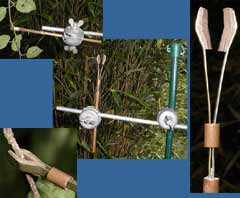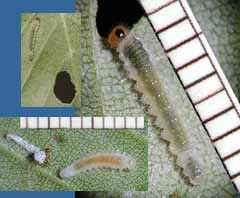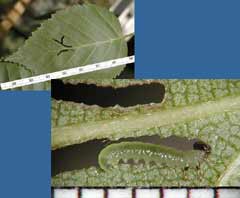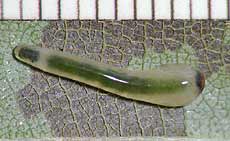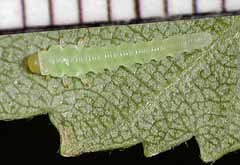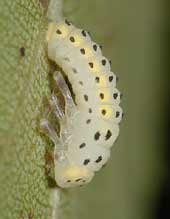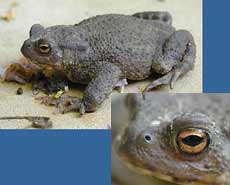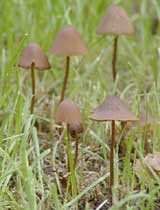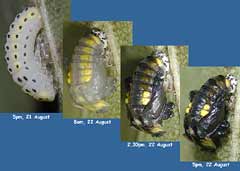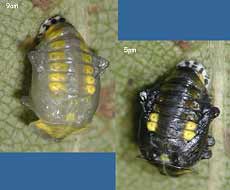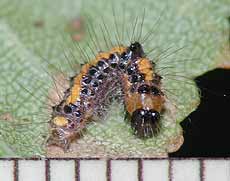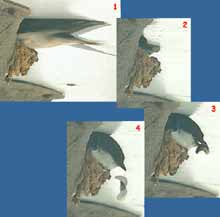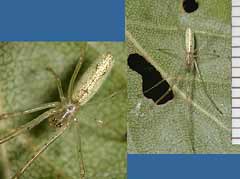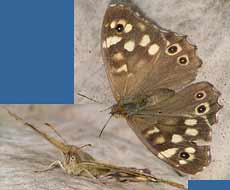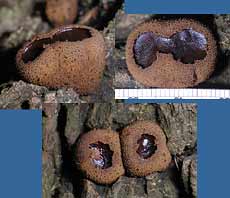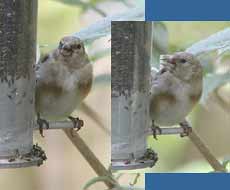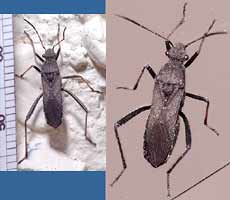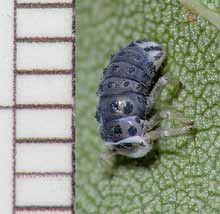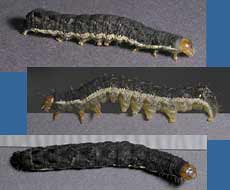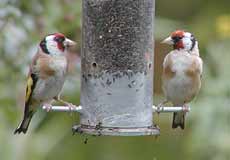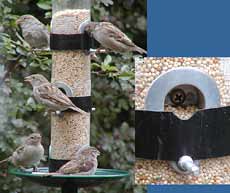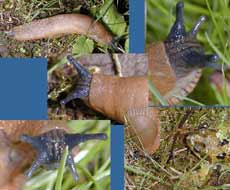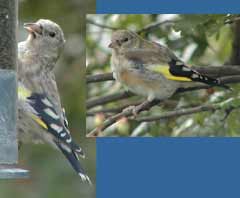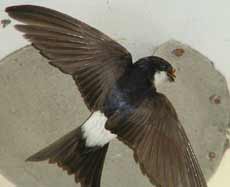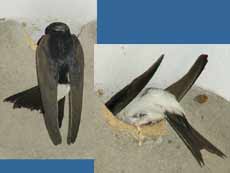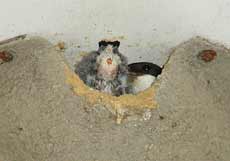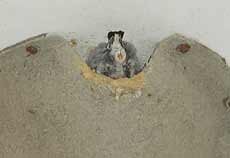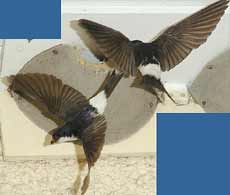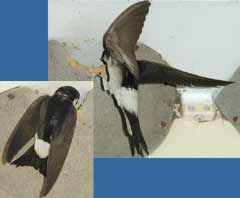Go to last entry of the month.....................Go to previous entry20 August - The weather continues to tease us. Yesterday morning a bit of rain gave way to a bright and sunny, if very breezy day which made photography a bit frustrating. This morning is also bright and sunny, but with lots of very threatening clouds around us.
The picture shows it set up to hold a branch on the Birch tree as I tried to take photographs of a couple of the sawfly larvae shown below. The clamp consists of two brass strips, bent at one end to form a jaw which is padded with bits of draught excluder. The strips are soldered into the end of a copper tube, and a small piece of the same tubing can be slid along the strips to open and close the clamp.
There are lots of small holes in the leaves and yesterday evening I found this sawfly larva munching away at one. The left-hand images were taken yesterday, and the lower one shows it just after moulting in the evening. The image on the right shows it this morning.
Numerous leaves have narrow, track-like holes eaten in them, and this morning I spotted this sawfly larva as it fed. When disturbed it would drop its tail out of sight on the opposite side of the leaf, leaving only its head in sight.
You can see how this one has eaten away all the tissue between the system of veins on the leaf.
This larva was photographed on the Birch yesterday and by late this morning it had hardly moved and had shown no signs of having been feeding.
This morning however, several of the larvae, like this one, can be seen undergoing their transformation into pupae. Its tail end is securely attached to the leaf and the rest of its body is just hanging down. A few have already completed that change over the last few days. At 11 30am I've just found a adult for the first time for a couple of weeks. It is quite pale and just a couple of leaves away from an empty pupal skin which I had overlooked. Perhaps the Autumn population has started to appear. 21 August - A bright, sunny day with no rain, but it is definitely getting cooler now. We haven't eaten indoors since long before our trip to Cornwall, but this morning it was necessary to dig out warm tops for the first time, although it did warm up later.
This is only the second one I have seen here this summer. The first one, a couple of weeks ago disappeared before I could photograph it.
The grass 'hill' up to the West Wing has sprouted gill fungi over the last couple of days, reflecting the damp conditions that have plagued us this summer. On the topic of fungi, another bit of encouragement arrived last night - a fungus picture that I took last year is to be used on the cover of a publication from the US Environmental Protection Agency.
22 August - Another nice day, with much of it spent helping one of my sons clear parts of the garden of the house he has just bought. I've brought home a few souvenirs in the form of some rotting tree branches!
This sequence of photographs shows its dramatic change in the 24 hours since 5pm yesterday afternoon.
This second pair of images show the pupa from a different angle as it appeared this morning and as it was at 5pm today. In all the images taken today you can see a black and white ring around the point of attachment to the leaf. This is the skin that was shed as the larva moulted during last night. I shall try to catch the moment when the adult emerges in a couple of weeks time.
On the other side of the Birch I found this tiny larva, measuring around 7mm in length - not one I can remember seeing here before. I've had a close look at it without removing it from the leaf and I think it has four pairs of prolegs (the legs at the rear of the body) which suggests that it is a caterpillar rather than a sawfly larva.
The House Martins' behaviour hasn't changed yet so I guess that we do not have chicks yet. In the garden, the House Sparrows spend a great deal of time chirping in the Hawthorn, often joined by numerous noisy juvenile Starlings. The Starlings spend a lot of their time feeding on the peanuts and at the end of the afternoon they join up with all the others in the area and fly off to somewhere west of us to roost. Otherwise, bird activity is very restricted. We have some visits from Collared Doves and Wood Pigeons. A female Chaffinch and a solitary Goldfinch come to feed each day, but I only catch an occasional glimpse of a Robin and rarely hear a Blackbird.
23 August - Weather-wise a disappointing day with many showers and only brief periods of sunshine. However, this morning got off to a good start when the postman delivered a spotting scope purchased on eBay - it's in perfect condition, and was quickly put to use. There were three Goldfinches here to look at, and a Great Tit appeared in the garden for the first time since the youngsters fledged back on 19 May.
This afternoon I spotted one dropping a faecal sac from the nest. I have since checked through a 4hr video and found that the martins are now going back and forth much more frequently, with both parents away from the nest more often. Also, I saw eight faecal sacs being disposed of. This sequence shows a parent arriving, turning around with what I assume is an insect in its mouth (pic 2), and then reappearing shortly after with a faecal sac which was dropped onto the porch above our front door! A check of the porch this evening revealed some 50+ sacs which is too many for just today. Based on the nine seen in the 4hr video I guess that some 20-25 may have been produced today. This means that hatching must have occured either during or before the weekend. Taking photographs outside was problematic today, with the showers and a gusty breeze. I missed a shot of an Orange Ladybird larva moulting, and an adult emerging from a pupa.
However I did manage to get a picture of this tiny spider, one of three similarly sized individuals on the lower branches of the Birch tree. I think it if a member of the Tetragnathidae, although I cannot match it to any of the spider illustrations I have.
24 August - Another showery day but with no heavy rain, and cool - very autumnal!
It was facing away from the sun with the front of its body raised, presumably to get its wings in the best position relative to the sun. Other that the Large Whites, butterflies are few and far between at the moment.
A fungus caught my attention this morning. These fruiting bodies have appeared on a piece of oak that is slowly rotting away under the Ivy tree. The largest is just under 2cm across. A first look through my fungi guides has failed to come up with an ID. I've looked through a video of the Martins' nest recorded between 7 - 11am and it showed that there was an adult in the nest for all but 36 minutes of the 4 hours. The adults swapped places 16 times and I saw 5 faecal sacs being removed. On just one occasion an adult flew up to the entrance and appeared to be feeding a bird inside, without actually entering the nest.
A couple of hours later there was a treat when one of the adults returned, accompanied by a juvenile, the first time I can recall seeing a young Goldfinch in the garden. It was a pity that by the time I got my camera sorted out the adult had left the feeder.
A few days ago, and again this morning we have heard loud pecking/hammering on my neighbour's side of a fence panel. Could it be a Nuthatch, or a Woodpecker? We saw nothing appear over the fence, but my guess favours the Nuthatch, which I have only ever seen two fleeting glimpses of in our garden. 27 August - After a dry day yesterday this morning was dull and wet and quite cool. This afternoon was dry and warmer. We've had a trio of Goldfinches here again today, two adults and a juvenile which spent ages at the feeder. There was a Robin here after what seems like a long absence.
When it flies I can see a red band down the back of the abdomen. A look through my insect guides suggests that it is Alydus calcaratus, an insect that is normally found on heathland and other dry habitats. Perhaps it's looking for somewhere that is actually dry!
On the birch tree another Orange ladybird emerged yesterday and there are more pupae to be seen now. What I did spot this afternoon was this larva that appeared to be either pupating or moulting, but by tonight there had been no change. I shall check again tomorrow morning.
29 August - Another dry, if rather cloudy day yesterday, and this morning it is overcast and I can see the occasional drip disturbing the surface of the birdbath. The larva in the picture above is still hanging from the leaf this morning, looking darker but otherwise unchanged. Yesterday morning I noticed that the mud added to the front of the nestbox by the Martins had fallen off. Despite this they seem to be continuing as normal. During the afternoon there was a Long-tailed Tit feeding at the peanuts.
The top of it was almost black and I have made these images slightly lighter to try to show some detail. Below the light band, the lower body had a definitely green tinge.
The gloom of the morning was interrupted for a while by this pair of Goldfinches. I was hoping for another glimpse of the youngster, but that hasn't appeared by lunchtime.
For a long time the House Sparrows have presented me with a problem. I have found that the food they like best seems to be 'Budgie Food', which consists of White and Red Millet and Canaryseed. However, the small round seeds flow out of the feeder opening far too easily and there has been a great deal of spillage. I had tried putting a large flowerpot tray below it to catch the seed, but while it has worked it has not looked too good and tends to get messy very easily.
This weekend I have replaced the tray with a smaller one and added a tightly fitting, black plastic collar around each pair of openings, with a notch to fit over the perch, and a larger notch at the top. As the larger image shows, the Sparrows are happy with the new arrangement, and there seems to be far less spillage so far.
There was an amusing moment when a frog that had been watching the slug's progress couldn't resist an attempt at catching it, tempted, I assume, by the constant movement of the slug's antennae. The image (bottom right) shows the frog just after its futile plunge.
This time I was able to use the Land Rover as a hide and get these pictures of it. Once again, it spent ages at the feeder, always on the 'wrong side', but this time it perched long enough on an exposed branch of the Hawthorn for me to grab a couple of shots, although they were not as sharp as I would have liked.
Today we could hear the House Martin chicks, and I have now put up a scaffold tower at the front of the house in order to get some photographs. I had intended to put some sort of cover over the top but the Martins didn't seem to mind my presence. It is quite a challenge to capture them in flight and I ended up with quite a few 'empty' shots. I was lucky when this parent arrived with a beakful of food for the chicks.
At the nest they sometimes feed the chicks from the entrance, but at other times they enter the nest. The speed with which they arrive meant that most of my photographs were like these two.
I did manage to get a couple of glimpses of chicks, but not their front ends! While one of the parents was still in the nest, one chick reversed its rear end over the lip of the nest and deposited a faecal sac onto the porch below. It happened several times more while I was watching. I didn't realise that they did this.
31 August - A dry day with a sunny afternoon to end what has been a very disappointing August. I've been up on the tower again, watching the House Martins. There is still no sign of the chicks front ends, although they reversed up to the entrance a number of times while I was watching. I'm hoping that someone can tell me the approximate age of the chick from the size of the tail feathers.
The parents seem to return with food every 4-5 minutes, but sometimes their approach is aborted at the last moment. This seems to happen especially if the chicks are quiet. Here I've blended two images of such an approach. You can see that the parent still has food in its beak as it flies away from the nest.
However, the sound of the parent outside alerts the chicks and they start chirping. Within a very short time the adult returns and the food is delivered. Click on images to see larger versions
Twice during the times I spent watching, the feeding pattern was interrupted by the presence of a Sparrow Hawk on patrol quite high above the houses. The Martins disappeared completely while it was about.
|
|
